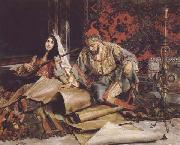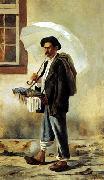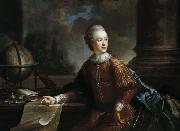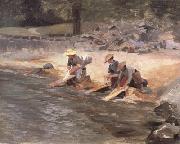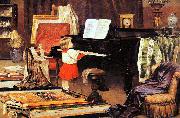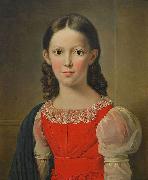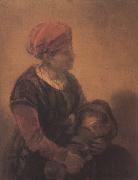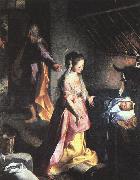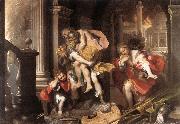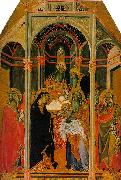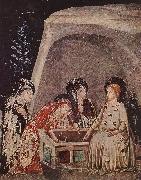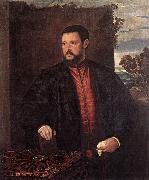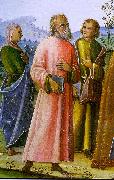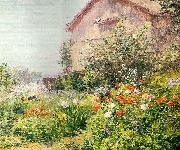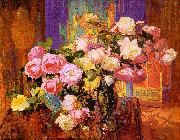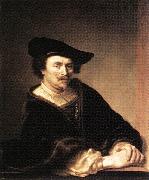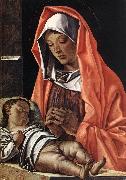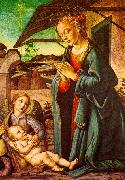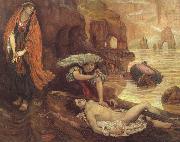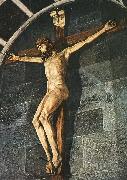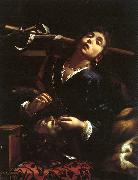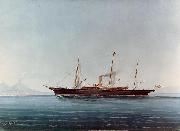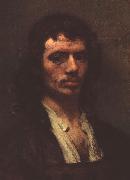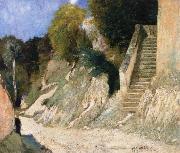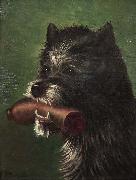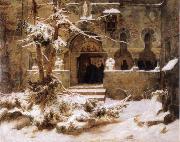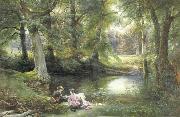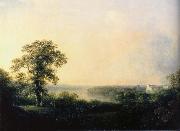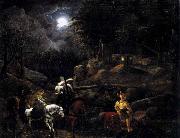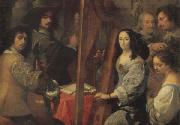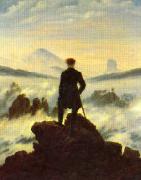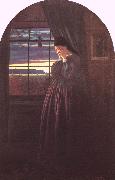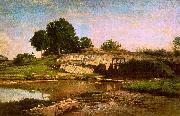|
|
|
|
|
|
|
|
 |
Antonio Fontanesi
|
|
23 February 1818 - 17 April 1882) was an Italian painter who lived in Meiji period Japan between 1876 and 1878. He introduced European oil painting techniques to Japan, and exerted a significant role in the development of modern Japanese yega (Western style) painting. He is known for his works in the romantic style of the French Barbizon school.
Fontanesi was born in Reggio Emilia, Emilia-Romagna, and trained with the landscape painters Prospero Minghetti and Vincenzo Carnevali. From 1841 to 1846 he made theatre sets and began painting landscapes. In 1850, he moved to Geneva, where he stayed until 1865. His main area of interest was landscape painting, which he expanded on after visiting the 1855 Exposition Universelle in Paris. He participated in important artistic exhibitions, displaying his works in Lyon, Turin, Milan, Florence, Genoa and the Triennial Exhibition of Fine Art in Bologna. He was nominated professor at the Academy of Lucca, but moved to Turin when a chair as a landscape professor was created specially for him at the Accademia Albertina in Turin from 1869 to 1876.
|
|
|
|
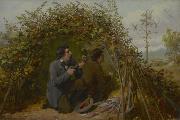 |
Arthur Fitzwilliam Tait
|
|
(February 5, 1819 -April 28, 1905) was an American artist who is known mostly for his paintings of wildlife. During most of his career, he was associated with the New York City art scene.
Tait was born in Lively Hall near Liverpool, England. At eight years old, because his father went bankrupt he was sent to live with relatives in Lancaster. It is during that time that he became attached to animals. Later on, in Manchester, England, Agnew & Zanetti Repository of Art acquired Arthur Tait who began self-learning to paint, as a twelve-year-old boy. |
|
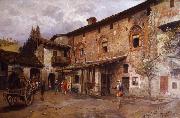 |
Arturo Ferrari
|
|
(Milan, 1861 - 1932) was an Italian painter.
Initiated into artistic studies by his father Cesare, an associate of Luigi Scrosati, and the painter Mose Bianchi from Lodi, Arturo Ferrari completed his training at the Brera Academy under the guidance of Giuseppe Bertini from 1877 to 1884 while working in the studio of Gerolamo Induno at the same time. He made his debut at the Esposizione di Belle Arti di Brera in 1879 with a view of the interior of Milan Cathedral, thus inaugurating the repertoire of Milanese perspective views that was to be a constant feature of his vast production of oil paintings and watercolours. He soon became the guiding spirit of a poetic and sentimental evocation of "Old Milan" during the phase of transition to the 20th century, when the face of the city changed radically through wholesale rebuilding. A regular participant in all the major exhibitions until 1932, the year of his death, he was the recipient of numerous marks of official recognition and enjoyed considerable success with the public as well as the esteem of conservative critics.
|
|
|
|
|
|
|
|
|
|
|
|
|
|
|
|
|
|
|
|
|
|
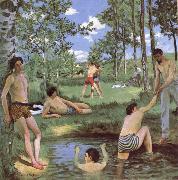 |
Bazille, Frdric
|
|
Studied under Charles Gleyre.
French Impressionist Painter, 1841-1870
|
|
|
|
|
|
|
|
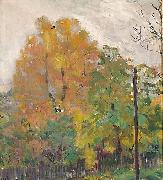 |
Bernhard Folkestad
|
|
1879 - 1933) was a Norwegian essayist and painter. He was born in London, where his father assisted at the Norwegian Seamen Mission. Among his painting teachers were Kristian Zahrtmann and Laurits Tuxen. His paintings Mørkeloftet from 1905, and Høns i høstsol and Grønnsaker from 1906 are all located in the National Gallery of Norway. Among his books are Svingdøren from 1926, Sol og morild from 1929, and Gullfisken from 1933. |
|
|
|
|
|
|
|
|
|
|
|
|
|
|
|
|
|
|
|
|
|
|
|
|
|
|
|
|
|
|
|
|
|
|
|
|
|
|
|
|
|
|
|
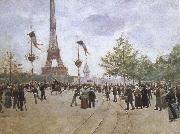 |
cesar franck
|
|
For playwright Frances Burney (1776 C 1828), niece of novelist Fanny Burney Madame d'Arblay 1752-1840, see Frances Burney (1776?C1828)
|
|
|
|
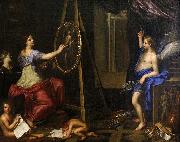 |
Charles Alphonse du Fresnoy
|
|
(1611C1665), French painter and writer on his art, was born in Paris, son of an apothecary.
He was destined for the medical profession, and well educated in Latin and Greek; but, having a natural propensity for the fine arts, he would not apply to his intended vocation, and was allowed to learn the rudiments of design under Perrier and Vouet. At the age of twenty-one he went off to Rome, with no resources; he drew ruins and architectural subjects.
After two years thus spent he re-encountered his old fellow-student Pierre Mignard, and by his aid obtained some amelioration of his professional prospects. He studied Raphael and the antique, went in 1633 to Venice, and in 1656 returned to France. During two years he was now employed in painting altar-pieces in the château du Raincy, landscapes, etc. His death was caused by an attack of apoplexy followed by palsy; he expired at Villiers-le-Bel, near Paris. He never married.
His pictorial works are few; they are correct in drawing, with something of the Caracci in design, and of Titian in colouring, but wanting fire and expression, and insufficient to keep his name in any eminent repute.
He is remembered now almost entirely as a writer rather than painter. His Latin poem, De arte graphica, was written during his Italian sojourn, and embodied his observations on the art of painting; it may be termed a critical treatise on the practice of the art, with general advice to students. The precepts are sound according to the standard of his time; the poetical merits slender enough. The Latin style is formed chiefly on Lucretius and Horace. |
|
 |
Charles de La Fosse
|
|
(June 16, 1636 - December 13, 1716), French painter, was born in Paris.
He was one of the most noted and least servile pupils of Le Brun, under whose direction he shared in the chief of the great decorative works undertaken in the reign of Louis XIV. Leaving France in 1662, he spent two years in Rome and three in Venice. The influence of his prolonged studies of Veronese is evident in his "Finding of Moses" (Louvre), an in his "Rape of Proserpine" (Louvre), which he presented to the Royal Academy as his diploma picture in 1673. He was at once named assistant professor, and in 1674 the full responsibilities of the office devolved on him, but his engagements did not prevent his accepting in 1689 the invitation of Lord Montagu to decorate Montagu House.
He visited London twice, remaining on the second occasionetogether with Rousseau and Monnoyer more than two years. William III vainly strove to detain him in England by the proposal that he should decorate Hampton Court, for Le Brun was dead, and Mansart pressed La Fosse to return to Paris to take in hand the cupola of Les Invalides. The decorations of Montagu House are destroyed, those of Versailles are restored, and the dome of the Invalides (engraved, Picart and Cochin) is now the only work existing which gives a full measure of his talent. During his latter years La Fosse executed many other important decorations in public buildings and private houses, notably in that of Crozat, under whose roof he died on 13 December 1716.
This article incorporates text from a publication now in the public domain: Chisholm, Hugh, ed (1911). Encyclopædia Britannica (11th ed.). Cambridge University Press.
|
|
|
|
|
|
|
|
|







